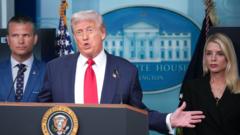In a press briefing at the White House, Trump described the situation in DC as one of "complete and total lawlessness." He stated, "I'm announcing a historic action to rescue our nation's capital from crime, bloodshed, bedlam, and squalor." While Trump feels the city has been overwhelmed by gangs and crime, local statistics indicate that violent crime has actually decreased significantly, with homicides dropping to their lowest rates in over 30 years.
Democratic Mayor Muriel Bowser has countered Trump's narrative by emphasizing the city's security improvements, asserting that despite a spike in crime in 2023, crime rates have since declined. “We are not experiencing a crime spike,” Bowser commented, reflecting on the efforts made to reduce violent offenses. The ongoing debate between local government and federal interventions draws attention to the federal oversight provisions permitted under the District of Columbia Home Rule Act, a regulation allowing the president to take control of the city’s police force under certain emergency conditions.
Bowser expressed her concerns about the implications of deploying the National Guard and stated that the federal government’s assumptions about DC's security situation are unfounded. Meanwhile, Trump also touched upon the issue of homelessness, declaring his aim to rid the city of what he described as "slums," although details regarding the proposed actions remain vague. Local advocates for the homeless countered that recent efforts have led to positive outcomes and argued that displacement would only exacerbate the plight of vulnerable populations.
As these controversial plans unfold, protests against Trump's intervention have emerged, reflecting widespread community apprehension regarding potential federal overreach. Activists have rallied against the measures, chanting "hands off DC" and labeling the president's focus on control as politically motivated rather than safety-oriented.
Incidents of violence against federal employees within the city further fueled Trump’s assertions that DC faces significant security threats, and he called these acts a “threat to America.” The deployment serves as a stark reminder of Trump’s commitment to addressing concerns surrounding the capital, following his earlier deployments in response to civil unrest and the Capitol riot in 2021.
As the situation continues to evolve, both the local government and the Trump administration's strategies will be closely scrutinized as they aim to find a balance between safety and the rights of residents in Washington DC.
Democratic Mayor Muriel Bowser has countered Trump's narrative by emphasizing the city's security improvements, asserting that despite a spike in crime in 2023, crime rates have since declined. “We are not experiencing a crime spike,” Bowser commented, reflecting on the efforts made to reduce violent offenses. The ongoing debate between local government and federal interventions draws attention to the federal oversight provisions permitted under the District of Columbia Home Rule Act, a regulation allowing the president to take control of the city’s police force under certain emergency conditions.
Bowser expressed her concerns about the implications of deploying the National Guard and stated that the federal government’s assumptions about DC's security situation are unfounded. Meanwhile, Trump also touched upon the issue of homelessness, declaring his aim to rid the city of what he described as "slums," although details regarding the proposed actions remain vague. Local advocates for the homeless countered that recent efforts have led to positive outcomes and argued that displacement would only exacerbate the plight of vulnerable populations.
As these controversial plans unfold, protests against Trump's intervention have emerged, reflecting widespread community apprehension regarding potential federal overreach. Activists have rallied against the measures, chanting "hands off DC" and labeling the president's focus on control as politically motivated rather than safety-oriented.
Incidents of violence against federal employees within the city further fueled Trump’s assertions that DC faces significant security threats, and he called these acts a “threat to America.” The deployment serves as a stark reminder of Trump’s commitment to addressing concerns surrounding the capital, following his earlier deployments in response to civil unrest and the Capitol riot in 2021.
As the situation continues to evolve, both the local government and the Trump administration's strategies will be closely scrutinized as they aim to find a balance between safety and the rights of residents in Washington DC.




















